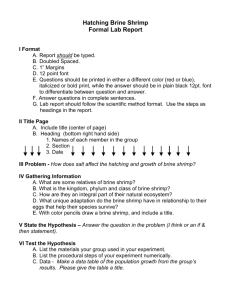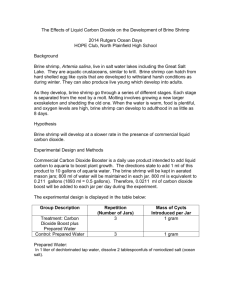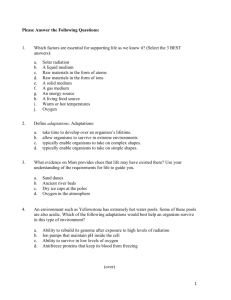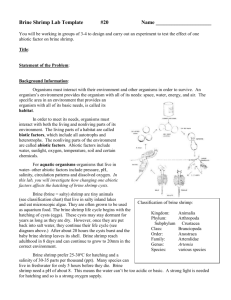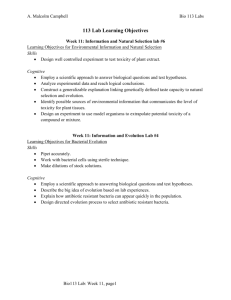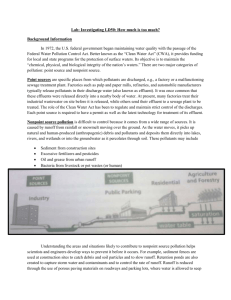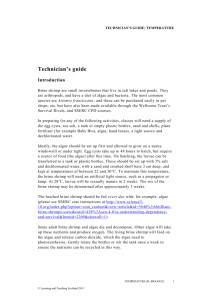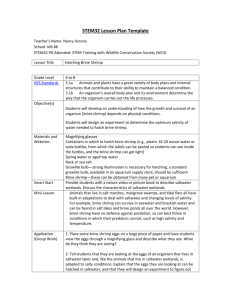Understanding Ocean Acidification with Brine Shrimp
advertisement
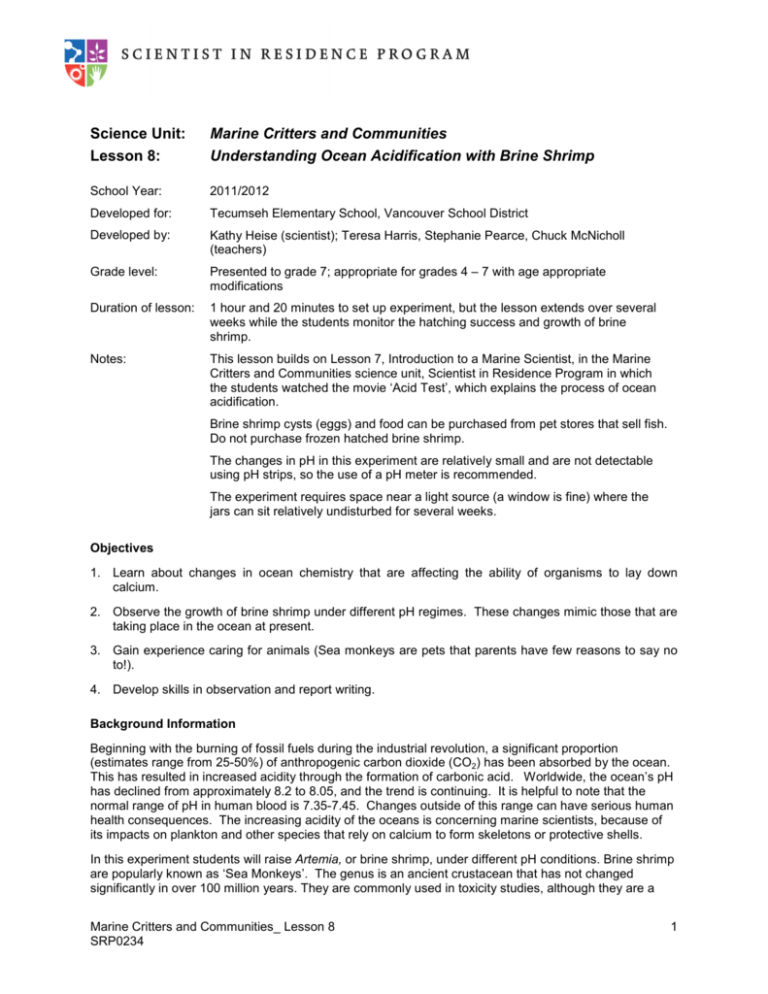
Science Unit: Lesson 8: Marine Critters and Communities Understanding Ocean Acidification with Brine Shrimp School Year: 2011/2012 Developed for: Tecumseh Elementary School, Vancouver School District Developed by: Kathy Heise (scientist); Teresa Harris, Stephanie Pearce, Chuck McNicholl (teachers) Grade level: Presented to grade 7; appropriate for grades 4 – 7 with age appropriate modifications Duration of lesson: 1 hour and 20 minutes to set up experiment, but the lesson extends over several weeks while the students monitor the hatching success and growth of brine shrimp. Notes: This lesson builds on Lesson 7, Introduction to a Marine Scientist, in the Marine Critters and Communities science unit, Scientist in Residence Program in which the students watched the movie ‘Acid Test’, which explains the process of ocean acidification. Brine shrimp cysts (eggs) and food can be purchased from pet stores that sell fish. Do not purchase frozen hatched brine shrimp. The changes in pH in this experiment are relatively small and are not detectable using pH strips, so the use of a pH meter is recommended. The experiment requires space near a light source (a window is fine) where the jars can sit relatively undisturbed for several weeks. Objectives 1. Learn about changes in ocean chemistry that are affecting the ability of organisms to lay down calcium. 2. Observe the growth of brine shrimp under different pH regimes. These changes mimic those that are taking place in the ocean at present. 3. Gain experience caring for animals (Sea monkeys are pets that parents have few reasons to say no to!). 4. Develop skills in observation and report writing. Background Information Beginning with the burning of fossil fuels during the industrial revolution, a significant proportion (estimates range from 25-50%) of anthropogenic carbon dioxide (CO2) has been absorbed by the ocean. This has resulted in increased acidity through the formation of carbonic acid. Worldwide, the ocean’s pH has declined from approximately 8.2 to 8.05, and the trend is continuing. It is helpful to note that the normal range of pH in human blood is 7.35-7.45. Changes outside of this range can have serious human health consequences. The increasing acidity of the oceans is concerning marine scientists, because of its impacts on plankton and other species that rely on calcium to form skeletons or protective shells. In this experiment students will raise Artemia, or brine shrimp, under different pH conditions. Brine shrimp are popularly known as ‘Sea Monkeys’. The genus is an ancient crustacean that has not changed significantly in over 100 million years. They are commonly used in toxicity studies, although they are a Marine Critters and Communities_ Lesson 8 SRP0234 1 fairly robust species. Brine shrimp are found in inland saltwater lakes, and are tolerant of extremely salty o conditions. Their ideal growing conditions are in bright light, with a temperature between 26 and 31 C. The eggs (cysts) are able to survive many years if kept in dry conditions. Once introduced into salt water, hatching can be observed within 24-48 hours. After a few days, the brine shrimp can be fed very small amounts of food. It is important to not overfeed them and do not feed them if the water remains cloudy for more than a couple of hours. Note brine shrimp are not found in the ocean, likely because they are highly vulnerable to predation. They are able to adapt to extreme conditions (high salinity) that few other species are capable of surviving in. Vocabulary Ocean acidification: Chemical changes in the ocean that result from carbon dioxide emissions in the atmosphere being absorbed by the ocean. Plankton: Small marine organisms that drift in the water and are a critical component of marine food webs pH: A logarithmic scale used to describe the acidity or alkalinity of a solution Materials • 21 250 ml jars with lids (or 3 per group of 4 students) • 10 litres of boiled (sterilized) saltwater from the ocean. • Brine shrimp eggs and food • Measuring spoons (1/8, ¼ and ½ tsp) • Vinegar • Warm classroom space near a window or source of light • Magnifying glass • pH meter • Graph paper • Airstones (optional) for bubbling air into the jars after the experiment has been going on for a few days • 7 -8 waterproof different coloured markers (one per group) to label jars • Dissecting microscope with camera • Additional Excel worksheet ‘Class results of brine shrimp experiment’ • Ruler In the Classroom Introductory Discussion 1. Begin the lesson with a short discussion reviewing threats to the ocean, with an emphasis on ocean acidification, making sure they understand the pH scale, which they are taught earlier in the school year. Sample discussion questions: • If the oceans are getting more acidic, is the pH going up or down? • What animals will be affected if there are significant changes in plankton abundance? • What might that mean to marine food webs? 2. Introduce the basic biology and life cycle of sea monkeys, or brine shrimp, as the study animal in this experiment. Marine Critters and Communities_ Lesson 8 SRP0234 2 • Why do you think brine shrimp a good choice as a study animal if we want to know more about increasing acidity? • Why might brine shrimp not be the best choice as a study animal in this study? 3. Outline the experimental set-up for the study - Science Experiment 1. The students will be raising brine shrimp under three different conditions: salt water, salt water with 1/8 tsp vinegar, and salt water with either ¼ or ½ tsp vinegar added (allow the students to choose). The hatching success and growth of the brine shrimp under these different scenarios will be monitored by the students on a daily basis, for several weeks. Each student should maintain their own records, although observations can be done collectively. Science Activity/Experiment Experiment Title: Increasing acidity and its effects on the hatching and growth of brine shrimp. Purpose of Experiment: To better understand how an indicator species, brine shrimp, may be impacted by increasing acidification of their habitat. Experimental Treatments: Brine shrimp will be grown under 3 different pH regimes of increasing acidity Control treatment- Jar 1 Sterilized saltwater from the ocean Test treatment 1- Jar 2 Sterilized sea water with 1/8 tsp vinegar added Test treatment 2- Jar 3 Sterilized sea water with either ¼ or ½ tsp vinegar Students will record the (approximate) number of living brine shrimp under these 3 different pH regimes. Ideally, a pH meter will be used to quantify the changes in pH that result from the addition of vinegar. Prediction or Hypothesis: If brine shrimp are raised under conditions of increasing acidity, then hatching success and survival will be reduced. Methods and Instructions: Set-up prior to experiment: Boil the seawater for best results and allow it to cool before the lesson. In class: 1. Students will work in groups of 3-4. Each group will obtain 3 jars, and fill them with 250ml of sterilized sea water. Label each jar with a different coloured waterproof marker. Label the jar, not the lid, so that the jars can be reused. Ask one group to measure the pH of the sterilized water. This measurement needs to be recorded by each group. Jar 1 in each group will be the control. 2. In jar 2 add 1/8 tsp of vinegar, and add ¼ or ½ tsp vinegar to jar 3 (the students can choose, but they need to record the amount on their data sheets). Share the pH meter around the room so that each group can measure and record the pH of jars 2 and 3. 3. For the sake of consistency, one person, ideally the scientist or teacher, should walk around the room and add a small pinch of brine shrimp cysts to each jar. 4. Place the jars near a window or other light source. If necessary, place a heater near the jars. Hatching will be delayed or reduced if the temperature is too cool. 5. Each day monitor the jars for signs of hatching. The tiny brine shrimp nauplii are barely visible, so it may be necessary to use a magnifying glass to observe them swimming up and down throughout the water. Do not shake the jars. Enter the results on the data sheet. Approximately once a week, sketch to scale some of the brine shrimp, in one of the boxes on the back of the data sheet. Marine Critters and Communities_ Lesson 8 SRP0234 3 6. After young brine shrimp nauplii have begun hatching, the students can feed them. It is very important that they only provide a small dusting of food on the water. If the water becomes cloudy, the brine shrimp are overfed. Stop feeding, and wait for the water to clear before adding more food. This may take 2 to 3 days. If an air-bubble stone is available, the students can aerate each jar occasionally. Make sure to rinse the bubble stone between jars each time it is used. 7. After approximately 2 to 3 weeks, the results of the experiment should be clear, and students can graph their results on the attached sheet ‘Analyze your data’. References 1. Mitchell, Alanna. 2009. Seasick: the Global Ocean in Crisis. McClellan and Stewart Publishing. 2. <http://www.pmel.noaa.gov/co2/files/noaa_oa_factsheet.pdf> NOAA State of the Science Fact Sheet: Ocean Acidification. May 2008. Accessed May 21, 2012. Ocean 3. <http://www.epoca-project.eu/index.php/what-do-we-do/outreach/rug/oa-the-facts.html> Acidification Reference User Group. 2009. Ocean Acidification: the facts. A special introductory guide for policy advisers and decision makers. Laffoley, D. d’A and J.M. Baxter (eds.) European Project on Ocean Acidification (EPOCA). Accessed May 21 2012. 4. <http://en.wikipedia.org/wiki/Brine_shrimp> Brine Shrimp. Accessed May 21 2012. Extension of Lesson Plan 1. As a class, students can contribute their results to worksheet ‘Class results of brine shrimp experiment’, and discuss them. 2. The students can write up the results of their experiment in a formal lab report, following the guidelines below. Marine Critters and Communities_ Lesson 8 SRP0234 4 Data Sheet to Record Brine Shrimp Growth Start Date: __________________ Group Members: _________________________________________________________________ Jar # ______ Colour______ Amount vinegar added ______ Date hatching first observed: _____________ Date Estimate # of Ave. Length Other Observations (sketch animals, water conditions, Hatched Shrimp (mm) etc.) Jar # ______ Amount vinegar added ______ Date hatching first observed: __________________ Date Estimate # of Ave. Length Other Observations (sketch animals, water conditions, Hatched Shrimp (mm) etc.) Marine Critters and Communities_ Lesson 8 SRP0234 5 Jar # ______ Amount vinegar added ______ Date hatching first observed: __________________ Date Estimate # of Ave. Length Other Observations (sketch animals, water conditions, Hatched Shrimp (mm) etc.) Sketch the developmental stages of your brine shrimp below (be sure to include a scale): Days since hatching ________ Days since hatching ________ Days since hatching ________ Days since hatching ________ Marine Critters and Communities_ Lesson 8 SRP0234 6 Analyze your Data: Graph the Results of Your Brine Shrimp Experiment Jar 1 pH = _____ Jar 2 pH = ____ Legend: Jar 1 ______ Jar 2 ______ Jar 3 pH = ______ Jar 3 _______ Plot the number of days since the experiment started on the x axis, and the approximate number of living brine shrimp on the y axis. Did the results surprise you? Why or why not? ___________________________________________ __________________________________________________________________________________ __________________________________________________________________________________ What is your conclusion from this experiment? __________________________________________ __________________________________________________________________________________ Marine Critters and Communities_ Lesson 8 SRP0234 7 Guidelines for the Lab Report from the Experiment on ‘Understanding Ocean Acidification’ Title: Centered, and Specific to the Lab Question: What is the general question that we were asking about the world? What is the more specific question we are asking to research/explore the larger question? Hypothesis: An “if . . . then” statement that describes what we did to the brine shrimp. What do you expect to see happen (dependent variable) when you make the change (independent variable)? Remember not to use “I.” Materials: A list of all materials (be specific with amounts). Procedure: List every step. What did you do so that someone else could repeat this exact experiment? Don’t forget to include safety tips: eg. ‘Don’t shake the shrimp.’ Also include instructions on labeling, feeding, observing and recording. Data and Observations: Insert your data charts, as well as any observations you noted. Analysis: Insert your graph and discuss your results. What do you think the results mean? Does acidity affect the brine shrimp? If all of your brine shrimp died, discuss what could have been the cause. Remember to identify the control, independent, and dependent variables. What worked, what didn’t work. What did you learn? Conclusion: Do you accept or reject your hypothesis? Applications: Choose a minimum of two real life professions that could use your research findings and explain how they may use this information. (ex. environmentalist, scientist, aquarium owner) BONUS: Explain what you might do differently if you were to redo this experiment to make it more accurate (i.e. control variables). OR Explain a different experiment that you might like to do on brine shrimp (Why? What do you hope to learn? How would you conduct it?) Be sure to include your name! Marine Critters and Communities_ Lesson 8 SRP0234 8

